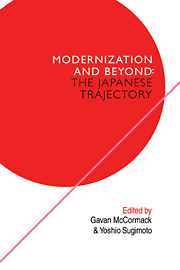Book contents
- Frontmatter
- Contents
- Contributors
- Introduction: modernization and beyond
- I Popular culture: tradition and ‘modernization’
- 1 Sumō and popular culture: the Tokugawa period
- 2 Osaka popular culture: a down-to-earth appraisal
- 3 New trends in Japanese popular culture
- II Popular movements: alternative visions of ‘modernization’
- III Uneven development and its discontents
- IV Sex, politics and ‘modernity’
- V ‘Modernization’ and ‘modernity’: theoretical perspectives
- Glossary
- Index
2 - Osaka popular culture: a down-to-earth appraisal
Published online by Cambridge University Press: 04 August 2010
- Frontmatter
- Contents
- Contributors
- Introduction: modernization and beyond
- I Popular culture: tradition and ‘modernization’
- 1 Sumō and popular culture: the Tokugawa period
- 2 Osaka popular culture: a down-to-earth appraisal
- 3 New trends in Japanese popular culture
- II Popular movements: alternative visions of ‘modernization’
- III Uneven development and its discontents
- IV Sex, politics and ‘modernity’
- V ‘Modernization’ and ‘modernity’: theoretical perspectives
- Glossary
- Index
Summary
INTRODUCTION
The framework for the following analysis of Osaka popular culture has been borrowed from Roland Barthes (see figure). Following the Barthian model, this discussion of Osaka popular culture in its social and historical context will begin at the level of least abstraction; that is, at the most basic and blunt area of popular culture, what I will call food culture. In looking at the place of food in the urban Osaka culture I came up with two phenomena to be explored later in this paper: tako-yaki, a foodstuff charged with symbolic significance, and a huge moving crab sign, an example of a visual symbol of a foodstuff (S'e). That which gives meaning to both of these is the food ideology in Osaka (Sa). This ideology will be looked at by considering the historical, social, and cultural development of Osaka, and especially emphasized will be the development of the area of the city known as Minami. (Part # 1)
Once an understanding of the characteristics of Osaka's (and by extension, Japan's) popular culture is attained in this way, we will be able to analyze the relationship through which the verbal text known as manzai (S'e) or Japanese comic dialogue, receives its meaning from the general Osaka popular culture (Sa). From this newfound vantage point we should be able to make an adequate appraisal of Osaka's popular culture in the twentieth century. (Part # 2)
- Type
- Chapter
- Information
- The Japanese TrajectoryModernization and Beyond, pp. 33 - 53Publisher: Cambridge University PressPrint publication year: 1988



